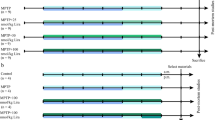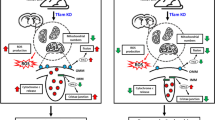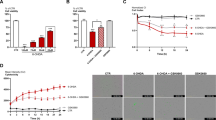Abstract
Parkinson’s disease (PD) is a multifactorial disorder, and there is strong evidence that mitochondria play an essential role in the disorder. Factors that regulate the mechanism of the mitochondrial quality control system have been drawing more and more attention. PGC-1α (peroxisome proliferator-activated receptor-γ coactivator-1α) is a powerful transcription factor involved in regulation of mitochondrial function. Glucagon-like peptide 1 (GLP-1), a brain-gut peptide, can enter the central nervous system through the blood–brain barrier and play neuroprotective role. However, whether the GLP-1R agonist liraglutide regulates mitochondrial quality control system through PGC-1α is still unclear. We administered different doses of liraglutide to intervene MPTP (1-methyl-4-phenyl-1,2,3,6-tetrahydropyridine)-induced PD model, and then immunofluorescence, Western blot, and stereotactic injection of lentivirus to downregulate PGC-1α were used to explore the mechanisms underlying the protective effect of liraglutide in PD. The results showed that MPTP lead to decreased mitochondrial biogenesis, disrupted mitochondrial dynamics, inhibited mitochondrial autophagy, and promoted cell apoptosis. While liraglutide effectively attenuated the neurotoxicity of MPTP, including reversing the dyskinesia caused by MPTP and preserving the expression of GLP-1R, TH, and PGC-1α in the substantia nigra (SN), further experiments showed that downregulation of PGC-1α expression via stereotactic injection PGC-1α lentivirus into the SN reversed the liraglutide protective effects. By PGC-1α downregulation, we found that PGC-1α can not only regulate mitochondria biogenesis, mitochondria dynamics, and autophagy, but also regulate cell apoptosis. In summary, liraglutide has a neuroprotective effect in the PD model induced by MPTP. This protective effect is accomplished by activating PGC-1α, which regulates the mitochondrial quality control system.







Similar content being viewed by others
Data Availability
All the data and material from this study are available upon reasonable request through the corresponding author.
References
Anzell AR, Maizy R, Przyklenk K, Sanderson TH (2018) Mitochondrial quality control and disease: insights into ischemia-reperfusion injury. Mol Neurobiol 55:2547–2564
Aroda VR (2018) A review of GLP-1 receptor agonists: evolution and advancement, through the lens of randomised controlled trials. Diabetes Obes Metab 20(Suppl 1):22–33
Athauda D, Maclagan K, Skene SS, Bajwa-Joseph M, Letchford D, Chowdhury K, Hibbert S, Budnik N, Zampedri L, Dickson J et al (2017) Exenatide once weekly versus placebo in Parkinson’s disease: a randomised, double-blind, placebo-controlled trial. Lancet 390:1664–1675
Badawi GA, Abd El Fattah MA, Zaki HF, El Sayed MI (2019) Sitagliptin and liraglutide modulate L-dopa effect and attenuate dyskinetic movements in rotenone-lesioned rats. Neurotox Res 35:635–653
Balestrino R, Schapira A (2020) Parkinson disease. Eur J Neurol 27:27–42
Brauer R, Wei L, Ma T, Athauda D, Girges C, Vijiaratnam N, Auld G, Whittlesea C, Wong I, Foltynie T (2020) Diabetes medications and risk of Parkinson’s disease: a cohort study of patients with diabetes. Brain 143:3067–3076
Cartoni R, Léger B, Hock MB, Praz M, Crettenand A, Pich S, Ziltener JL, Luthi F, Dériaz O, Zorzano A et al (2005) Mitofusins 1/2 and ERRalpha expression are increased in human skeletal muscle after physical exercise. J Physiol 567:349–358
Chen Y, Dorn GW II (2013) PINK1-phosphorylated mitofusin 2 is a Parkin receptor for culling damaged mitochondria. Science 340:471–475
De Pablo-Fernandez E, Goldacre R, Pakpoor J, Noyce AJ, Warner TT (2018) Association between diabetes and subsequent Parkinson disease: a record-linkage cohort study. Neurology 91:e139–e142
Dickson DW (2018) Neuropathology of Parkinson disease. Parkinsonism Relat Disord 46(Suppl 1):S30–S33
Fang X, Tian P, Zhao X, Jiang C, Chen T (2019) Neuroprotective effects of an engineered commensal bacterium in the 1-methyl-4-phenyl-1, 2, 3, 6-tetrahydropyridine Parkinson disease mouse model via producing glucagon-like peptide-1. J Neurochem 150:441–452
Farkas E, Szilvásy-Szabó A, Ruska Y, Sinkó R, Rasch MG, Egebjerg T, Pyke C, Gereben B, Knudsen LB, Fekete C (2021) Distribution and ultrastructural localization of the glucagon-like peptide-1 receptor (GLP-1R) in the rat brain. Brain Struct Funct 226:225–245
Gao W, Du X, Lei L, Wang H, Zhang M, Wang Z, Li X, Liu G, Li X (2018) NEFA-induced ROS impaired insulin signalling through the JNK and p38MAPK pathways in non-alcoholic steatohepatitis. J Cell Mol Med 22:3408–3422
González-Rodríguez P, Zampese E, Stout KA, Guzman JN, Ilijic E, Yang B, Tkatch T, Stavarache MA, Wokosin DL, Gao L et al (2021) Disruption of mitochondrial complex I induces progressive parkinsonism. Nature
Guan X, Wu P, Cao B, Liu X, Chen X, Zhang W, Zhang Y, Guan Z, Wang Y (2021) PGC-1α-siRNA suppresses inflammation in substantia nigra of PD mice by inhibiting microglia. Int J Neurosci :1–12
Göke R, Larsen PJ, Mikkelsen JD, Sheikh SP (1995) Distribution of GLP-1 binding sites in the rat brain: evidence that exendin-4 is a ligand of brain GLP-1 binding sites. Eur J Neurosci 7:2294–2300
Halling JF, Pilegaard H (2020) PGC-1α-mediated regulation of mitochondrial function and physiological implications. Appl Physiol Nutr Metab 45:927–936
Hunter K, Hölscher C (2012) Drugs developed to treat diabetes, liraglutide and lixisenatide, cross the blood brain barrier and enhance neurogenesis. BMC Neurosci 13:33
Hussain S, Singh A, Baxi H, Taylor B, Burgess J, Antony B (2020) Thiazolidinedione use is associated with reduced risk of Parkinson’s disease in patients with diabetes: a meta-analysis of real-world evidence. Neurol Sci 41:3697–3703
Jeong SY, Seol DW (2008) The role of mitochondria in apoptosis. BMB Rep 41:11–22
Jiang X, Jin T, Zhang H, Miao J, Zhao X, Su Y, Zhang Y (2019) Current progress of mitochondrial quality control pathways underlying the pathogenesis of Parkinson’s disease. Oxid Med Cell Longev 2019:4578462
Kim DS, Choi HI, Wang Y, Luo Y, Hoffer BJ, Greig NH (2017) A new treatment strategy for Parkinson’s disease through the gut-brain axis: the glucagon-like peptide-1 receptor pathway. Cell Transplant 26:1560–1571
Li T, Tu L, Gu R, Yang XL, Liu XJ, Zhang GP, Wang Q, Ren YP, Wang BJ, Tian JY (2020) Neuroprotection of GLP-1/GIP receptor agonist via inhibition of mitochondrial stress by AKT/JNK pathway in a Parkinson’s disease model. Life Sci 256:117824
Ma CL, Su L, Xie JJ, Long JX, Wu P, Gu L (2014) The prevalence and incidence of Parkinson’s disease in China: a systematic review and meta-analysis. J Neural Transm (vienna) 121:123–134
Ma D, Liu X, Liu J, Li M, Chen L, Gao M, Xu W, Yang Y (2019) Long-term liraglutide ameliorates nigrostriatal impairment via regulating AMPK/PGC-1a signaling in diabetic mice. Brain Res 1714:126–132
Peng K, Xiao J, Yang L, Ye F, Cao J, Sai Y (2019) Mutual antagonism of PINK1/Parkin and PGC-1α contributes to maintenance of mitochondrial homeostasis in rotenone-induced neurotoxicity. Neurotox Res 35:331–343
Peng K, Yang L, Wang J, Ye F, Dan G, Zhao Y, Cai Y, Cui Z, Ao L, Liu J et al (2017) The interaction of mitochondrial biogenesis and fission/fusion mediated by PGC-1α regulates rotenone-induced dopaminergic neurotoxicity. Mol Neurobiol 54:3783–3797
Puigserver P, Spiegelman BM (2003) Peroxisome proliferator-activated receptor-gamma coactivator 1 alpha (PGC-1 alpha): transcriptional coactivator and metabolic regulator. Endocr Rev 24:78–90
Raza C, Anjum R, Shakeel N (2019) Parkinson’s disease: mechanisms, translational models and management strategies. Life Sci 226:77–90
Rehman J, Zhang HJ, Toth PT, Zhang Y, Marsboom G, Hong Z, Salgia R, Husain AN, Wietholt C, Archer SL (2012) Inhibition of mitochondrial fission prevents cell cycle progression in lung cancer. FASEB J 26:2175–2186
Salcedo I, Tweedie D, Li Y, Greig NH (2012) Neuroprotective and neurotrophic actions of glucagon-like peptide-1: an emerging opportunity to treat neurodegenerative and cerebrovascular disorders. Br J Pharmacol 166:1586–1599
Shin JH, Ko HS, Kang H, Lee Y, Lee YI, Pletinkova O, Troconso JC, Dawson VL, Dawson TM (2011) PARIS (ZNF746) repression of PGC-1α contributes to neurodegeneration in Parkinson’s disease. Cell 144:689–702
Shu Z, Zhang X, Zheng L, Zeng G, Mo Y, Yu M, Zhang X, Tan X (2019) Epigallocatechin-3-gallate regulates mitofusin 2 expression through the peroxisome proliferator-activated receptor-γ coactivator-1α and estrogen-related receptor-α pathway. J Cell Biochem 120:7211–7221
Soriano FX, Liesa M, Bach D, Chan DC, Palacín M, Zorzano A (2006) Evidence for a mitochondrial regulatory pathway defined by peroxisome proliferator-activated receptor-gamma coactivator-1 alpha, estrogen-related receptor-alpha, and mitofusin 2. Diabetes 55:1783–1791
Surmeier DJ, Obeso JA, Halliday GM (2017) Selective neuronal vulnerability in Parkinson disease. Nat Rev Neurosci 18:101–113
Valerio A, Bertolotti P, Delbarba A, Perego C, Dossena M, Ragni M, Spano P, Carruba MO, De Simoni MG, Nisoli E (2011) Glycogen synthase kinase-3 inhibition reduces ischemic cerebral damage, restores impaired mitochondrial biogenesis and prevents ROS production. J Neurochem 116:1148–1159
Wang C, Li L, Liu S, Liao G, Li L, Chen Y, Cheng J, Lu Y, Liu J (2018) GLP-1 receptor agonist ameliorates obesity-induced chronic kidney injury via restoring renal metabolism homeostasis. PLoS One 13:e0193473
Wang Y, Zhao W, Li G, Chen J, Guan X, Chen X, Guan Z (2017) Neuroprotective effect and mechanism of thiazolidinedione on dopaminergic neurons in vivo and in vitro in Parkinson’s disease. PPAR Res 2017:4089214
Yoo SM, Jung YK (2018) A molecular approach to mitophagy and mitochondrial dynamics. Mol Cells 41:18–26
Youle RJ, van der Bliek AM (2012) Mitochondrial fission, fusion, and stress. Science 337:1062–1065
Zhang L, Zhang L, Li L, Hölscher C (2019) Semaglutide is Neuroprotective and reduces α-synuclein levels in the chronic MPTP mouse model of Parkinson’s disease. J Parkinsons Dis 9:157–171
Funding
This work was supported by grants from Science Foundation of Hebei Normal University under Grant Number L2020Z05, and Hebei Province Foundation for Returnees under Grant Number C20200341.
Author information
Authors and Affiliations
Corresponding author
Ethics declarations
Competing Interests
The authors declare no competing interests.
Additional information
Publisher's Note
Springer Nature remains neutral with regard to jurisdictional claims in published maps and institutional affiliations.
Supplementary Information
Below is the link to the electronic supplementary material.
Rights and permissions
About this article
Cite this article
Wu, P., Dong, Y., Chen, J. et al. Liraglutide Regulates Mitochondrial Quality Control System Through PGC-1α in a Mouse Model of Parkinson’s Disease. Neurotox Res 40, 286–297 (2022). https://doi.org/10.1007/s12640-021-00460-9
Received:
Revised:
Accepted:
Published:
Issue Date:
DOI: https://doi.org/10.1007/s12640-021-00460-9




